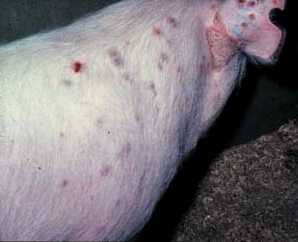



Swine Pox
Background and history
 Example of a pig with swine pox. |
This is a disease caused by the swine pox virus which can survive outside the pig for long periods of time and is resistant to environmental changes. It is a vesicular disease characterised by small circular red areas 10-20mm in diameter that commence with a vesicle containing straw-coloured fluid in the centre. After two to three days the vesicle ruptures and a scab is formed which gradually turns black. The lesions may be seen on any part of the body but are common along the flanks, abdomens and occasionally the ears. There is no treatment and the condition usually resolves itself spontaneously over a three week period.
It can be spread by lice or mange mites. It can be confused with localised greasy pig disease, pustular dermatitis and the allergic form of mange.
Clinical signs
All Pigs
- Small circular red areas 10-20mm in diameter that commence with a vesicle containing straw-coloured fluid in the centre.
- After two to three days the vesicle ruptures and a scab is formed which gradually turns black.
- The lesions may be seen on any part of the body but are common along the flanks, abdomens and occasionally the ears.
- A secondary dermatitis may occur.
- Unusual in piglets.
Diagnosis
It can be confused with localised greasy pig disease, pustular dermatitis and the allergic form of mange. Close examination shows swine pox lesions.
Causes
- It can be spread by lice or mange mites.
- Skin abrasions.
- Fighting and mixing of pigs.







